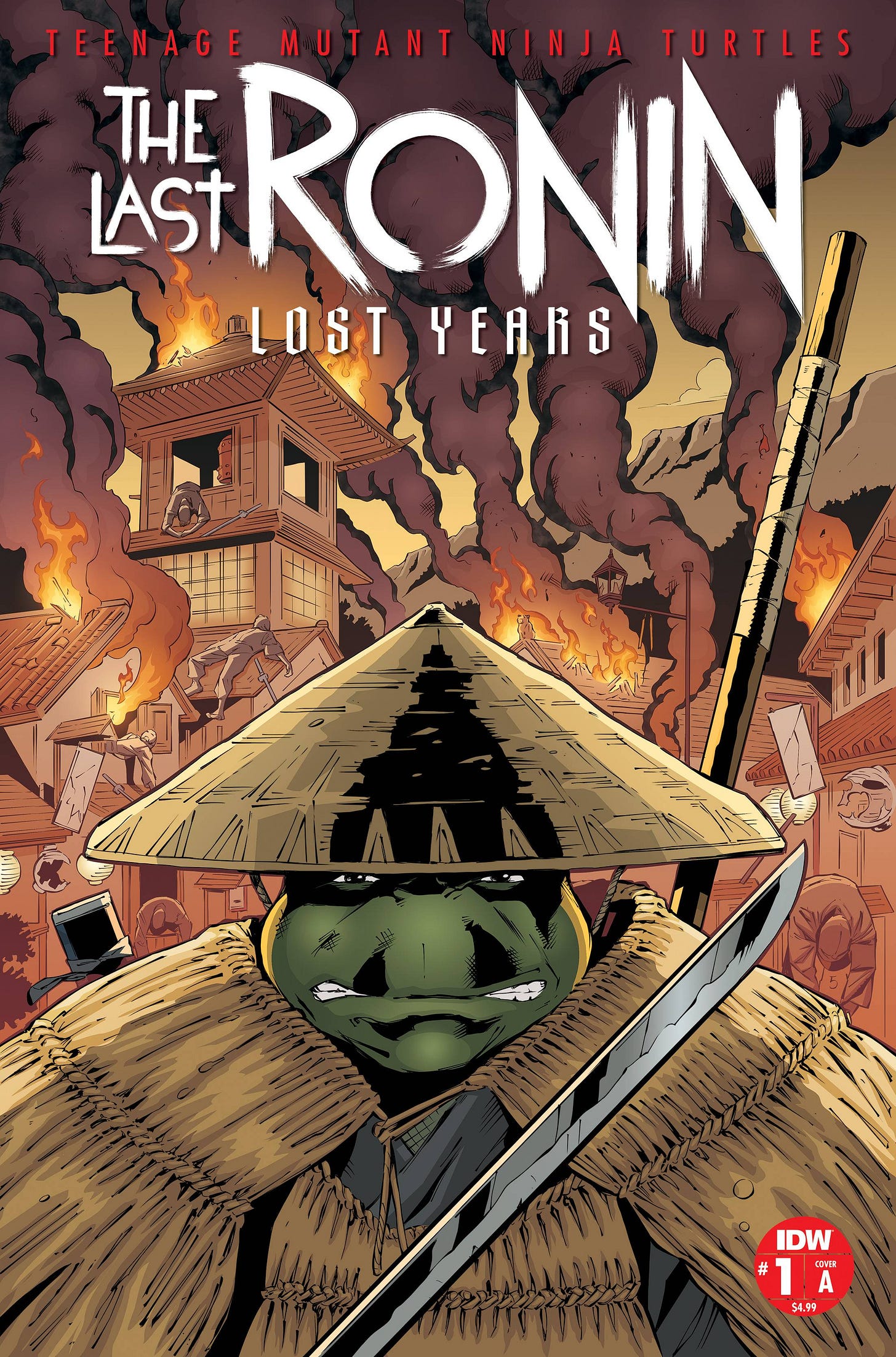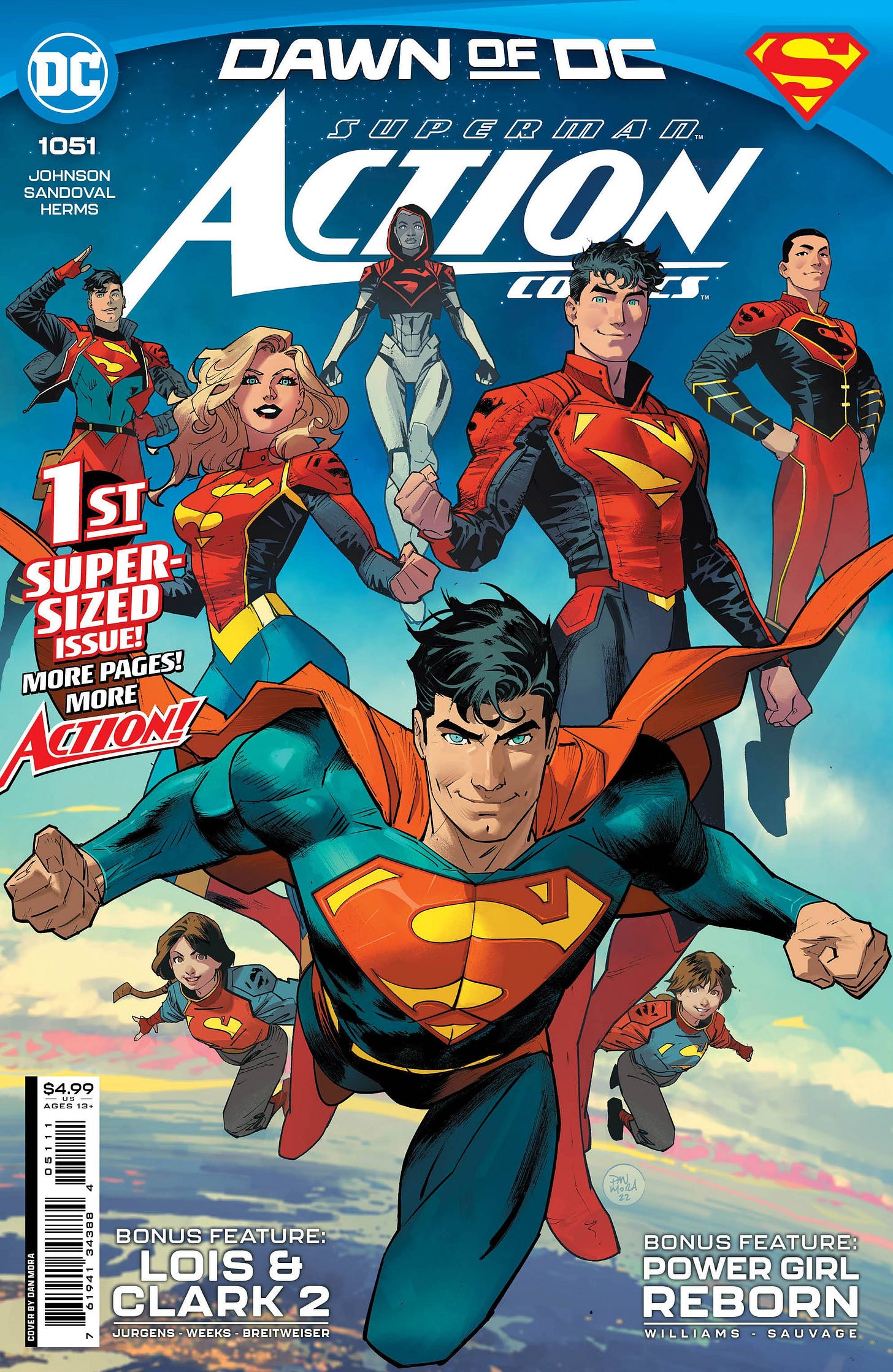Three Big Books, Three Different Approaches
Three comic companies tackle big ideas in unique ways.
You Read These With Your Eyes (Jan 25th, 2023)
A quick feature abut selling stories featuring the week’s newest reads.
This week we’re breaking things up by talking about three different comics from three different companies, all banking on some bigger projects.
MINI-SERIES | TMNT: The Last Ronin - Lost Years #1
by Kevin Eastman, Tom Waltz, SL Gallant, Maria Heane, Ben Bishop, Luis Antonio Delgado & Shawn Lee w/ editorial support by Nicolas Niño & Charles Beacham
TMNT: The Last Ronin was first hinted at in the back pages of TMNT’s 100th ongoing issue at IDW. A milestone on its own, the teaser for this new project featured the names of Kevin Eastman and Peter Laird together, hinting at the first collaboration between the pair since the ‘90s.
The collaboration turned out to be more of a “based on an idea by” situation, but the buzz remained. TMNT and comic fans alike were interested in what was to come. The first issue was released in late 2020 and blew up. At our shop, we were selling roughly quadruple of the main series and folks seemed to be quite engaged. With oversized instalments, the series featured considerable gaps between issues, but interest maintained. From anecdotal evidence (because sales charts are somewhat a thing of the past at the point) the series was a rousing success for many other shops too - and if I had to hazard a guess, it was far and away IDW’s best performing book of the past five years.
Jump to today with the company’s release of this companion series, that features more from The Last Ronin, filling in missing years as the characters remember past events. It isn’t surprising that the company would want to continue exploring this era of TMNT given how the audience engaged with the original series, and the story doesn’t feel like a lesser idea, like many spin-offs do. That said, there hasn’t been the same amount of buzz around this project - it would be hard to maintain something like that when it was built from the idea of a collaboration that barely happened - so this book will pretty much be selling off of inertia entirely. Which is to say:
The Pitch | A proactive retailer should be putting this book into the files of folks who bought the original mini-series, and expect a few copies to come back their way. There probably won’t be a lot of action on shelf, as this is very much a “hat on a hat” situation, where the refreshed concept is being reheated without a deeper hook, so there will be some loss. The real connection will be prompting folks who are curious, but missed the original series in single issues to check out the collected edition. That’s where the real hook lies, and it will give you the best opportunity to sell someone on this follow up. If you let them start with just the follow-up, there will be questions, and backtracking doesn’t allow for the same surprise hit as experiencing the concept fresh.
EVENT | Sins of Sinister #1 (Marvel Comics)
by Kieron Gillem, Lucas Werneck, Geoffrey Shaw, Marco Checchetto, Juan José Ryp, David Baldeón, Travel Foreman, Carlos Gómez, Federico Vicentini, David Lopez, Joshua Cassara, Stefano Caselli, Bryan Valenza, VC’s Calyton Cowles & Jay Bowen w/ editorial support by Lauren Amaro & Jordan D. White
Like all events, this is a pretty “deep weeds” situation. This is not a book that a person starts with, without a certain bit of concept literacy. A lot of context is provided for those in need, (I’m admittedly behind on my X-Men reading, and needed some clues), but there is no world where this should be put into the hands of a new reader. That said, the creative team and Marvel proper have built a nice little event engine here. Sinister has been up to some shenanigans and built out his own little small-scale Age of Apocalypse which marketing is really leaning into, and creative build a fantastic story with a lot of universe jarring happenings.
The Pitch | This is going into the hands of folks who have been purchasing Immortal X-Men, X-Men Red, and Legion of X, as those creative teams are the main engine behind this, and the short run series that will make up the bones. There’s going to be some interest in this as a result of the Age of Apocalypse style, and nostalgia being one hell of a drug, but a short sighted sale to someone who you think you can tip purely for nostalgia is a sucker’s bet. Sure, you’ll make the sale, but if you can tell the book won’t connect with the person in your bones, don’t push them any harder than they are going to push themselves. If they convince themselves, that’s fine, but if you rack up enough bad recommendations with a person, they’re either going to stop taking your recommendations, or worse, they’re going to jump shops, or sour on the medium in general, when push comes to shove.
ONGOING & JUMPING ON POINT | Action Comics #1051 (DC Comics)
Main feature by Phillip Kennedy Johnson, Rafa Sandoval, Matt Herms, & Dave Sharpe
Lois & Clark co-fature by Dan Jurgens, Lee Weeks, Elizabeth Breitweiser & Rob Leigh
Power Girl co-feature by Leah Williams, Marguerite Sauvage & Becca Carey
Editorial support by Jillian Grant, Brittany Holzherr & Paul Kaminski
I’ve been talking up DC quite a bit lately, and for good reason. This is the first official title as part of their Dawn of DC initiative that sees the line building better as an approach, instead of just rebuilding. It is early days, but the theme set up by Dark Crisis and Nightwing #100 continues to be consistent in this book. Without giving away much in the way of spoilers, the Superman family essentially commits to being proactive instead of being reactive, and give their future actions a bit of focus.
Beyond that, Action Comics adopts a new format as of this issue that somewhat mirrors something I proposed a while back - using a bigger character as a vehicle to tell more stories about characters or concepts that benefit from their appearances having a specific focus and meaning.1 I’m a huge fan of things like this, for the reasons listed in the footnote, and love that something like this is being used alongside the launch of an era.
That said, as a retailer looking for the best ways to put books into people’s hands, this jumping on point succeeds in most ways, but stumbles slightly on two smaller points. In the main story, there’s a bevy of folks that are part of the current Superman family. It is a lot of information to take in for anyone fresh to the line of books, and no efforts are taken to soft introduce these characters.
Given my druthers, as characters appeared, I would have had caption boxes float their name, with a bit of pithy context to give new readers some better footing. This was a tactic that the Ed Brubaker to Matt Fraction to Kieron Gillen era of Uncanny X-Men did quite well, communicating information about the character, while being interesting enough to keep folks already in the know entertained. All of the information a person needed in the main story eventually does come out in the story, but as the person tasked with building an audience, I think that tool would have helped quite a bit.
The second trick is fairly minor: The Lois & Clark co-feature is billed on the cover as a sequel with a “2”. There’s no reason for this. Yes, it follows up on a previous, well-liked series. But folks who will be excited for that follow-up would just as easily clock that without the demarkation. The creative team is listed. The intent is clear. The only thing having the “2” listed accomplishes is a required knowledge of something that has happened before - and you do not want that in when you’re building a jumping on point.
The Pitch | Action is a tasty mix of flavours, and a fairly easy package to sell. It runs the $4.99 price point that anchor books are moving to, but with more content. It works nicely to establish the feel of a new era for the Superman family, and accomplishes that handily. Action needs to go into the hands of folks who are looking for… well, action. The main story pegs it as some meat and potatoes stuff, in a good way. Superman and his chosen (and actual) family working to make the world a better place, just like when he was fighting slum lords in his early days. Then, there’s extra treats for folks to discover. A person might not connect with every bit of this, but there’s a lot to connect with in this package.
Which is to say, you can run a Batman all day with stories without a hook and people will buy it, but you can’t do the same thing with Robin - so utilize the versatility of an anchor to better tell, and sell stories that need specificity to break through in the market. Then, when you find a spark that works, you can potentially spin that off into something that stands up on its own.







